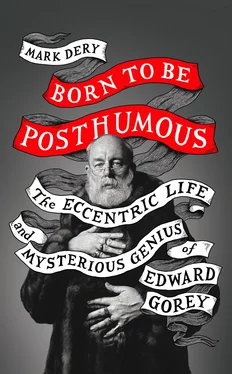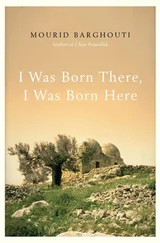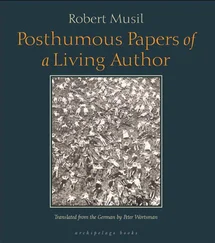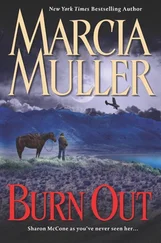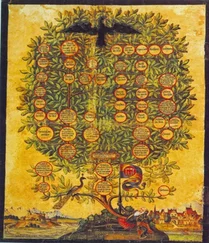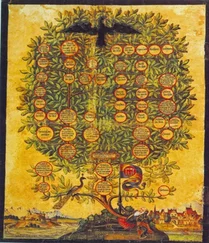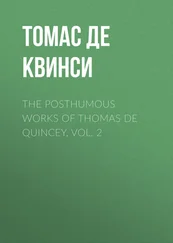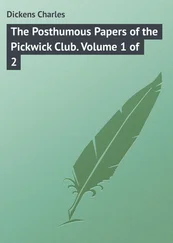Yet during his lifetime the art world and literary mandarins barely deigned to notice him or, when they did, dismissed him as a minor talent. His books are little, about the size of a Pop-Tart, and rarely more than thirty pages—mere trifles, obviously, undeserving of serious scrutiny. He worked in a children’s genre, the picture book, and wrote in nonsense verse. Even more damningly, his books are funny, often wickedly so. (Tastemakers take a dim view of humor.)
But the nail in Gorey’s coffin, as far as high-culture gatekeepers were concerned, was his status as an illustrator. For much of his lifetime, critics and curators patrolled the cordon sanitaire between serious art, epitomized by abstract expressionism, and commercial art, that wasteland of kitsch and schlock. Clement Greenberg, the high priest of postwar art criticism, dismissed all representational art as kitsch; illustration, it went without saying, was beneath contempt. Decades after abstract expressionism’s heyday, the art world was still doubling down on its disdain for the genre: a 1989 article in the Christian Science Monitor noted that prominent museums were “reluctant to display or even collect” illustration art, an observation that holds true to this day. 10By the same token, graduate programs discourage dissertations on the subject because, as a source quoted in the Monitor informed, “If you choose to get involved in a secondary art form, which is where American illustration fits in, you are regarded as a secondary art historian.”
Gorey didn’t help matters by standing the logic of the critical establishment on its head. He had zero tolerance for intellectual pretension and seemed to regard gravitas as dead weight, a millstone for the mind. Like the baroque music he loved, he had an exquisite lightness of touch, both in his inked line and in his conversation, which sparkled with quips and aperçus. He pooh-poohed the search for meaning in his work (“When people are finding meaning in things—beware,” he warned) and championed as aesthetic virtues (with tongue only partly in cheek) the inconsequential, the inconclusive, and the nonchalant. 11
Those virtues, as well as Gorey’s persona—a pose that incorporated elements of the aesthete, the idler, the dandy, the wit, the connoisseur of gossip, and the puckish ironist, wryly amused by life’s absurdities—were steeped in the aestheticism of Oscar Wilde and in the ennui-stricken social satire of ’20s and ’30s English novelists such as Ronald Firbank and Ivy Compton-Burnett, both of whom, like Wilde, were gay.
Gorey’s own sexuality was famously inscrutable. He showed little interest in the question, claiming, when interviewers pressed the question, to be asexual, by which he meant “reasonably undersexed or something,” a state of affairs he deemed “fortunate,” though why that should be fortunate only he knew. 12To nearly everyone who met him, however, his sexuality was a secret hidden in plain sight. There was the bitchy wit. The fluttery hand gestures. The flamboyant dress: floor-sweeping fur coats, pierced ears, beringed fingers, and pendants and necklaces, the more the better, jingling and jangling. And that campy delivery, plunging into sepulchral tones, then swooping into near falsetto. “Gorey’s conversation is speckled with whoops and giggles and noisy, theatrical sighs,” wrote Stephen Schiff in a New Yorker profile. “He can sustain a girlish falsetto for a very long time and then dip into a tone of clogged-sinus skepticism that’s worthy of Eve Arden.” 13Many of his intellectual passions—ballet, opera, theater, silent movies, Marlene Dietrich, Bette Davis, Gilbert and Sullivan, English novelists like E. F. Benson and Saki—were stereotypically gay. Nearly everyone who met him pegged him as such.
Viewing Gorey’s art through the lens of gay history and queer studies reveals fascinating subtexts in his work and argues persuasively for his place in gay history, situating him in an artistic continuum whose influence on American culture has been profound.
“At the heart of all of Gorey, everything is about something else,” his friend Peter Neumeyer, the literary critic, once observed. 14In his life as well as his art, he embraced opposites and straddled extremes. His tastes ranged from highbrow (Balthus, Beckett) to middlebrow ( Golden Girls , Buffy the Vampire Slayer ) to lowbrow (true-crime potboilers, Star Trek novelizations, the Friday the 13th franchise). He was equally unpredictable in his critical verdicts, pitilessly skewering dancers in George Balanchine’s ballets yet zealously defending, with a perfectly straight face, William Shatner’s animatronic acting. Allowing that his work might hark back “to the Victorian and Edwardian periods,” he pulled an abrupt about-face, asserting, “Basically I am absolutely contemporary because there is no way not to be. You’ve got to be contemporary.” 15
What you saw wasn’t always what you got. Take his name. It was too perfect. Edward fits like a dream because his neo-Victorian nonsense verse is modeled, unapologetically, on that of Edward Lear (of “The Owl and the Pussycat” fame). His mock-moralistic tales are set, more often than not, in Edwardian times. Moreover, Gorey was an eternal Anglophile, and Edward is one of the most English of English names, a hardy survivor of the Norman Conquest that dates back to Anglo-Saxon times, when it was Ēadweard —“Ed Weird” to modern eyes unfamiliar with Old English, an apt sobriquet for a legendary eccentric. (Did I mention that he lived, in his later years, in a ramshackle nineteenth-century house that he shared with a family of raccoons and a poison-ivy vine creeping through a crack in the living-room wall? Gorey was benignly tolerant of both infestations—for a while.)
As for Gorey , well, the thing speaks for itself: his characters often meet messy ends. The novelist and essayist Alexander Theroux, a member of Gorey’s social circle on Cape Cod, thinks “he felt obliged to be gory-esque, G-O-R-Y, because of that name.” “Nominative determinism,” the British writer Will Self calls it. 16No doubt, the body count is high in Gorey’s oeuvre. In his first published book, The Unstrung Harp , persons unknown may have drowned in the pond at Disshiver Cottage; in The Headless Bust , the last title published during his lifetime, “crocheted gloves and knitted socks” are found on the ominously named Stranglegurgle Rocks, leading the missing person’s relatives to suspect the worst. *
Bookended by this pair of fatalities, the deaths in Gorey’s hundred or so books include homicides, suicides, parricides, the dispatching of a big black bug with an even bigger rock, murder with malice aforethought, vehicular manslaughter, crimes of passion, a pious infant carried off by illness, a witch spirited away by the Devil, at least one instance of serial killing, and a ritual sacrifice (to an insect deity worshipped by man-size mantids, no less). In keeping with the author’s unshakable fatalism, there are Acts of God: in The Hapless Child , a luckless uncle is brained by falling masonry; in The Willowdale Handcar , Wobbling Rock flattens a picnicking family.
And, of course, infanticides abound: children, in Gorey stories, are an endangered species, beaten by drug fiends, catapulted into stagnant ponds, throttled by thugs, fated to die in Dickensian squalor, or swallowed whole by the Wuggly Ump, a galumphing creature with a crocodilian grin.
To relieve the tedium between murders, there are random acts of senseless violence and whimsical mishaps:
There was a young woman named Plunnery
Who rejoiced in the practice of gunnery,
Till one day unobservant,
Читать дальше
